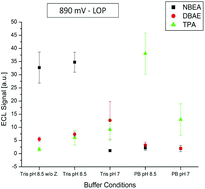Signal enhancement and low oxidation potentials for miniaturized ECL biosensors via N-butyldiethanolamine
Abstract
We present studies on ruthenium-based electrochemiluminescence (ECL) focusing on conditions supporting signal enhancement and low oxidation potentials. Low oxidation potentials (LOPs) are especially attractive for miniaturized ECL biosensors, as microfabricated electrodes tend to detach from their support when used with high currents and operated at high potentials. Furthermore, high potentials or current densities can lead to damage of typical biosensor surface coatings and biological probes. The possibility of generating LOP ECL signals at a potential below 900 mV was therefore studied for Ru(bpy)32+ with two typical coreactants, i.e. 2-(dibutylamino)ethanol (DBAE) and tripropylamine (TPA), as well as with the tertiary amine N-butyldiethanolamine (NBEA). Furthermore, the effect of buffer components and pH values on ECL signal generation was investigated. We could show a significant LOP ECL signal for NBEA. We found that Tris buffer, with its ability to form complexes with transition metal ions, has a positive influence on this ECL signal in terms of signal strength and LOP capabilities. Specifically, at basic pH values significant increases in ECL signals were observed at 900 mV and at 1.2 V. In fact, the ECL signal at 1.2 V was three times higher than the signal observed in phosphate buffer at a pH of 7, and it was thirty times higher than the ECL signal for TPA under these conditions. The LOP signal for NBEA in Tris buffer at pH 8.5 was similar to the signal obtained for TPA in phosphate buffer at pH 8.5 but three times higher than for TPA at pH 7.0. Interestingly, the coreactant DBAE was neither significantly influenced by the buffer system or pH nor did it present a valuable LOP ECL signal. Finally, it was found that high peak currents in cyclic voltammograms are not the indicators for high ECL signals, which should be obvious because the ECL mechanism requires more complex electron transfers. Overall, the standard TPA ECL at 1.2 V in phosphate buffer at pH 7.0 can successfully be replaced by NBEA ECL at 900 mV in Tris at pH 8.5 providing significantly higher signals accompanied by more gentle electrochemical conditions.



 Please wait while we load your content...
Please wait while we load your content...